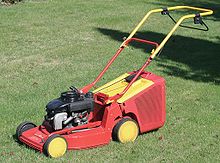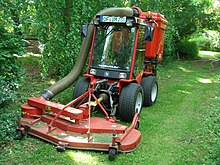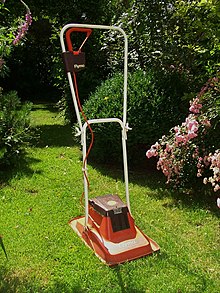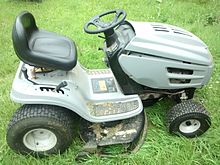mowing machine
A lawn mower is a garden tool used to mow a lawn . A distinction is made between:
- Cylinder mower with an exact cut but low area coverage
- Rotary mower with imprecise cut but high area coverage
history
In the 18th century , coming from England , a new form of garden art , the landscape garden with intensely tended pleasure grounds in the castle area, spread across Europe. In these huge parks, mowing with a scythe was an immense effort. At the beginning of the 19th century, for example, 50 employees were constantly mowing the lawn in the park at Blenheim Palace (England).
In parallel, in England sports such as lawn - tennis , football , croquet , cricket and rugby , which also require an intensive manicured lawns, and more popular.
Around 1830, Edwin Beard Budding (1795–1846), a textile engineer from Stroud in Gloucestershire , England , realized that there was no improvement in the hand scythe itself. But now he saw a machine in the local weaving mill : After weaving , it guided the fabric along a fixed blade and separated protruding fibers using a rotating spindle with additional blades in order to achieve a more even appearance. Budding transferred this principle to the grass cutting, announced on August 31, 1830 the mower, which he had invented in 1827, the patent and began with John Ferrabee, the owner of the Phoenix Mill this reel mower to produce.
The Ransomes company in Ipswich bought the Budding patent and began factory production in 1832 (according to other sources, 1836). Ransomes sold over 1000 lawnmowers by 1840, more than 7000 pieces by 1858 and developed the lawnmower further. Amariah Hills received the first US patent for a roller lawnmower on January 12, 1868 for their lawnmower called "Archimedean". The name chosen for this lawnmower goes back to the innovative cutting mechanism, which is similar to the Archimedean screw . In 1902, Ransomes developed the first motorized lawn mower.
A small museum in the Elizabethan mansion Trerice near Newquay in Cornwall displays historical models.
At the International Art and Horticultural Exhibition in 1904 in Düsseldorf, the company Gebr. Brill , Fabrik f. Lawn mowers along with garden tools, Barmen mechanical lawn mowers for a wide audience and advertised with the note “in most of the royal, princely. and urban gardens in use for over 20 years ”. Lawn mower . In: Otto Lueger (Hrsg.): Lexicon of the entire technology . 2nd Edition. Stuttgart, Leipzig 1904.
The first mass-produced rotary mower was brought onto the market in 1956 by the German company SOLO ( prototypes of which were shown at the DLG exhibition in Hanover in 1949 ).
According to an estimate by the manufacturer Briggs & Stratton, there are around five million petrol-powered lawnmowers in Germany today. Around 800 different types, including around 300 lawn mowers and around 200 lawn tractor models from more than 50 suppliers, are on the market.
technology
A distinction is made depending on the type and arrangement of the cutting tools
- Cylinder mower,
- Sickle or rotary mower and
- Bar mower .
Cylinder mower
On a rotating spindle (with a horizontal axis transverse to the direction of movement of the mower) arranged upper blades cut the blades of grass against a fixed lower blade (scissors principle), which results in a clean cross-section. Depending on the setting of the lower knife, the knives sharpen themselves automatically or the knife set has to be re-sharpened manually. Cylinder mowers are used wherever a high cutting quality, exactly even cutting heights (minimum 7 mm) are important (e.g. golf courses and other lawn sports fields ). The support rollers attached behind the lower blade as spacers lead to a characteristic stripe pattern of the freshly mown lawn when mowing alternately due to the remaining incline of the blades of grass. Since the rotating spindle "catches" the blades of grass from above, grass with a height greater than the spindle radius can only be mowed with difficulty. Lawns must therefore be mowed more often with cylinder mowers than with sickle mowers. The frequent cutting leads to increased water loss from the blades of grass through the cut surface, which requires artificial watering of the lawns. As a result, cylinder mowers are more likely to be used in areas with higher rainfall (England, Australia).
Rotary mower
In sickle mowers , horizontally arranged blades rotate on a vertical shaft at high speed and thereby cut the grass in a free cut without a counter blade , the cross- section of the cut is fibrous and irregular. Kinked stalk residues and stalk fibers wither and cause a stronger brown tint of the cut, dried lawn than is the case when mowing with a cylinder mower. The majority of hand-operated lawn mowers are sickle mowers, some with two cutter bars ("knife cross"). The cutting elements can be screwed-on knives or sharpened knife bars. The two cutter bar halves are usually provided with a certain aerodynamic angle of attack - similar to that of a propeller - in order to generate an air flow from below through the plane of rotation upwards. As a result, the cut crop is transported up above the cutting plane and blown into a container through appropriately shaped channels in the housing or high centrifugal forces hurl it laterally outwards into a grass catcher.
Large sickle mowers with movable blades used in agriculture are called rotary mowers .
Air cushion mower
Air cushion mowers are a sub-variant of sickle mowers. They differ in their design from conventional hand-operated sickle mowers with running wheels in that a fan creates overpressure under the bell housing in which the cutter bar rotates, and thus the housing at a certain distance from the ground takes off. As a result, the mower hovers on an air cushion , similar to a hovercraft , and can be moved in all directions using the guide rail. That is why they are mainly used in sloping and winding areas. The disadvantage of this principle is the fact that the blown air flow required for hovering depresses the blades of grass instead of erecting them, thereby limiting the cutting performance.
Robotic lawn mowers
Robotic lawnmowers, which act as mulching mowers, mow an area independently without human guidance, promise particular comfort. They draw their energy from a battery that can be fed by solar cells or is automatically recharged at a charging station. Built-in sensors react to any obstacles that may appear. The area to be mowed is usually limited by a buried power cable, the inductance of which the mower detects.
Ride-on mowers and lawn tractors
Self-propelled mowers with seating are called ride-on mowers (also known as "riding mowers"), more complex variants are lawn tractors . A special form of the ride-on mower is the zero turn mower .
Until 1980, the rule was that vehicles with a maximum speed of 6 km / h could be driven without registration, tax and without a driving license. This also included ride-on mowers and lawn tractors. In the meantime this law has been overtaken. Therefore, these vehicles may only be driven with a valid driving license. For this purpose, the driver license classes L and T are required, as this involves driving agricultural and forestry vehicles. In order for ride-on mowers to be used in road traffic for a short time, the road traffic approval regulations must also be complied with and a green license plate applied for and installed.
Further distinguishing criteria
According to the type of drive, lawn mowers are divided into the following categories:
- Hand mowers , mostly designed as cylinder mowers,
- Electric mower (power cord or battery ),
- Petrol mower with two or four stroke petrol engine ,
- Front-engined lawn tractors like a tractor ,
- Ride-on mower with the engine behind the driver.
Petrol and electric mowers are further divided into devices
- without wheel drive,
- with wheel drive,
- with electric start (petrol mower only).
Mulching mowers chop up the crop and leave it as mulch on the lawn, where it rots and serves as lawn fertilizer and food for soil organisms. The time spent on disposing of clippings is no longer necessary.
Lawn mower and the environment
Exhaust gases
The environmental impact of petrol-powered lawnmowers is a constant topic of discussion. Their pollutant balance is in fact significantly worse than that of modern car engines; a lawnmower with a two-stroke engine emits just as many pollutants per liter of petrol consumed as a car from the 1930s. That is why the German Greens proposed in the summer of 2000 that the use of gasoline mowers should be banned when there was a risk of smog . The planned regulation failed, however. In 2011 almost all lawnmowers with four-stroke engines were sold. Their noise level is slightly lower than that of 2-stroke mowers; the pollutant emissions, however, are significantly reduced. Catalytic converter silencers have also been used for a number of years . In order to reduce the hydrocarbon emissions of four-stroke engines, which are still high , alkylate petrol ( appliance petrol or “green petrol”) is available; however, at over € 3 / liter (2009), it is more than twice as expensive as regular gasoline.
"We estimate that on a sunny weekend day the devices contribute ten to 15 percent to the ozone pollution " ( Axel Friedrich , Head of the Transport Department of the Federal Environment Agency)
Noise emission
On August 29, 2002, the Equipment and Machine Noise Protection Ordinance came into force in Germany , which is based on the European Directive 2000/14 / EC of May 8, 2000.
It applies to all noisy garden tools such as lawn mowers, grass trimmers , brush cutters, grass trimmers, grass edge trimmers, hedge trimmers, chain saws , leaf blowers , leaf blowers , leaf collectors and high-pressure cleaner and light equipment. Lawn mowers that are regarded as environmentally friendly produce a maximum of 88 decibels, while petrol-powered lawn trimmers usually achieve 90 to 95 decibels.
Since then, many of these devices, including lawnmowers of all kinds - including those without motors - have been allowed on working days, i.e. from Monday to Saturday from 8:00 p.m. to 7:00 a.m. and on Sundays, in residential areas, small settlement areas, spa and clinic areas and areas for foreigners. and public holidays are not operated.
For brushcutters, grass trimmers, grass edge trimmers, hedge trimmers, chain saws, leaf blowers, leaf blowers and leaf collectors, there are even longer periods of non-operation. In addition to the prohibition time from 8:00 p.m. to 7:00 a.m. on working days, these devices may also be used from 7:00 a.m. to 9:00 a.m., 1:00 p.m. to 3:00 p.m. and 5:00 p.m. to 8:00 p.m. : 00 clock cannot be operated. They must not be switched on on Sundays and public holidays. An infringement can be punished as an administrative offense according to § 62 BImSchG with a fine of up to 50,000 euros. Federal highways and railways of federal railways that run through residential areas are excluded from the restriction.
However, it should be noted that since the new ordinance, federal states or municipalities have been allowed to modify the provisions. According to this, further fixed prohibition times at lunchtime can be prescribed, for example. It is advisable to find out more about the regulations from the respective municipality.
CO 2 balance
According to a US study from 2010, the ability of an intensely tended lawn (city park) to bind carbon dioxide is exceeded many times over by the global warming potential of the maintenance measures.
Risk of accident
In Germany there are 7,000 accidents with lawnmowers every year. The most common causes are mowing by children, running over unprotected toes, manual clearing of grass discharge openings, stones and knife parts thrown away and the loosening of blocked knives when the electric mower is switched on, which immediately restart and injure the fingers when the blockage is cleared. Such injuries often lead to amputations. Modern devices have an automatic knife stop in the form of a dead man's device , which, as soon as a bracket on the handlebar is no longer depressed, switches off the drive and stops the knife immediately. Ride-on mowers and small tractors have a similar safety circuit which switches the machine off when the driver's seat is relieved (seat switch).
Robotic lawnmowers were also classified as poor in terms of safety by Stiftung Warentest, and limbs such as children's feet or outstretched hands were not recognized. Small animals are also at risk, especially if the devices are used at dusk or at night.
Lawn mower in motorsport
A new type of motorsport discipline are lawn mower races, in which ride-on mowers are equipped with powerful engines and used for races.
Individual evidence
- ^ Blenheim: Park from 1705. British History Online, 1990, accessed August 17, 2020 .
- ^ Adam Hart-Davis: Local Heroes - Edwin Budding and the Lawnmower. inventricity.com, accessed on August 17, 2020 .
- ↑ About the invention of the lawn mower .
- ↑ Felix Müller: An Englishman invents the razor for the lawn. Die Welt online, accessed on August 17, 2020 .
- ↑ Publication on US patent .
- ^ History of Mowing - as reflected by Ransomes Jacobsen. Eigca.org, March 29, 2017, accessed August 17, 2020 .
- ^ Trerice - National Trust Collections. National Trust Collections, accessed August 17, 2020 .
- ↑ Solo Kleinmotoren: About us - Solo Kleinmotoren GmbH. Retrieved August 17, 2020 .
- ↑ Topic cylinder mower on gardora.at , accessed on October 21, 2011.
- ↑ Air cushion mower. (No longer available online.) Archived from the original on May 12, 2015 ; Retrieved April 25, 2015 . Info: The archive link was inserted automatically and has not yet been checked. Please check the original and archive link according to the instructions and then remove this notice.
- ↑ Topic ride-on mower , accessed on November 22, 2012.
- ↑ Catalyst requirement for lawn mowers? Report on Science ORF.at , accessed on October 21, 2011.
- ↑ Article by Angelika Hillmer in the Hamburger Abendblatt , accessed on September 27, 2011.
- ↑ How loud can a lawnmower be? RP online, June 12, 2009, accessed August 17, 2020 .
- ↑ How loud is a grass trimmer with gasoline? expertentesten.de, July 26, 2020, accessed on August 17, 2020 .
- ↑ Noise pollution from machines and devices outdoors ( memento from September 1, 2009 in the Internet Archive ), information from the environmental portal at berlin.de, accessed on October 21, 2011.
- ↑ Federal Environment Ministry: Topic machine noise .
- ↑ Additional regulations by federal states, cities or municipalities ( memento of the original from March 16, 2013 in the Internet Archive ) Info: The archive link was inserted automatically and has not yet been checked. Please check the original and archive link according to the instructions and then remove this notice. .
- ↑ Townsend-Small, Amy; Czimczik, Claudia: Carbon sequestration and greenhouse gas emissions in urban turf , in Geophysical Research Letters vol. 37, issue 2 (January 22, 2010), doi: 10.1029 / 2009GL041675
- ↑ Safety tips for mowing the lawn , accessed on October 20, 2011
- ^ ORF report , accessed on October 20, 2011.
- ↑ Stiftung Warentest 2018: Robotic lawnmower in the test: Two endanger children's feet , accessed on June 12, 2020
- ↑ Peter Carstens: How robotic mowers become deadly traps , in GEO , accessed on June 12, 2020
- ↑ NABU Lower Saxony: Lawn mowers and robotic lawn mowers are dangerous for animal gardeners , accessed on June 12, 2020
Web links
- Information sheet for lawnmowers for the hobby gardener (pdf) ( Memento from July 11, 2009 in the Internet Archive ) (240 kB)









